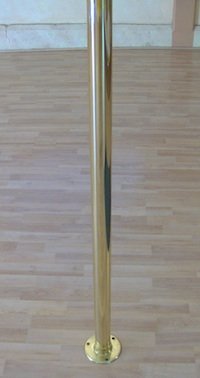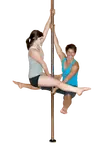- Home
- Pole Gear
- Dance Poles
- Permanent Dance Pole Info
Is A Permanent Pole Dancing Pole Right For You?
As it's name implies, a permanent pole dancing pole is one which is permanently attached to both the floor and ceiling.
 A permanent pole dancing pole shown with base plate secured to floor with screws.
A permanent pole dancing pole shown with base plate secured to floor with screws.Just to clarify, a dance pole that is attached to the ceiling by way of a mount that is screwed into the ceiling separately, is considered a semi-permanent or removable dance pole . . . unless of course it's also screwed into the floor, which definitely makes it permanent!
Confused yet? Hopefully you won't be after you read up on this particular type of pole dancing pole.
Why Choose A Permanent Pole Dancing Pole?
Permanent dance poles are most commonly found in studios, as well as clubs where pole dancing is performed.
The main reason for this choice is that, since there is normally no need to move the pole(s), there's also no point in dealing with the risks of installing a removable or friction mount model.
Since a permanent pole is the safest, especially in a situation when many different people may be using the equipment, this application makes good sense.
Some people also choose a permanent dance pole for their home for one or more reasons: they don't plan to move it once it's installed; they don't want to have to take it down and put it back up every time they want to use it, and/or they want the safest possible setup.
If you want to install a home dance pole and you only have one possible spot for it, and/or don't want the bother of putting it up and taking it down frequently, then a permanent pole may be the right choice for you.
However, unless you are very concerned about safety, a removable dance pole may also be a good choice for you, and one that gives you a bit more flexibility.
On the other hand, if safety is your primary concern, and you have the space to devote specifically to it, then a permanent dance pole is likely your best option.
Pros and Cons of Permanent Dance Poles
Permanent pole dancing poles have their pros and cons, just like any other type of pole. Hopefully this information will help you decide if this is the right choice for you.
Obviously, safety is a huge reason many people purchase this type of pole. These are by far the safest type available because they are permanently attached to both the floor and ceiling.
Convenience is another benefit of this setup. If you prefer not to have to put your pole up and take it down, a permanent installation is ideal for you. You install it once and that's it. Aside from regular inspections of the screws and/or rivets, there's not much to worry about.
However, the fact that the pole can't easily be removed once it's installed will be a disadvantage if you need to use your space for other activities, or if it's not convenient to have a dance pole in the middle of the room for any reason.
Another downside for some people is the actual
installation process. If your brain shuts down when you hear the buzz of
power tools at work, or if you don't know what a ceiling joist is,
installing a permanent pole may seem beyond your capabilities.
But
don't worry, you'll likely find that a friend is eager to help you out,
if for no other reason than bragging rights ("yep, I just helped Emily
install her new dance pole!").
Thinking that a permanent pole dancing pole might be right for you? Be sure to check out this dance pole review page for detailed information on all the different brands available.
If you've decided that a permanent pole is your best option, be sure to read this page on safety for permanent dancing poles.
What's New?
-
Find Colorado Pole Dancing Classes
Oct 31, 25 02:44 PM
Searching for Colorado pole dancing opportunities? Come on in and let us help you find a class near you with our free directory. -
Plus Size Dance Pole Guide - Top Poles with Higher Weight Limits
Jul 31, 25 03:03 PM
What's the best plus size dance pole? Not all poles are created equal. Find out which brands support higher weight limits, and which ones to avoid. -
Pole Dance Studios in Brazil | Global Pole Directory
Jul 26, 25 04:55 PM
Explore pole dance studios and instructors across Brazil. Find pole fitness classes for all levels and styles with the Brazil pole dancing directory. -
Pole Fitness in Hawaii | Worldwide Pole Dance Directory
Jul 14, 25 11:39 PM
Searching for pole fitness in Hawaii? Look no further! Discover pole studios and instructors across Hawaii and start your pole dance fitness adventure today! . -
London Pole Studios & More | Pole Dancing in England
Jul 13, 25 11:44 PM
Discover top pole studios in London as well as pole dancing classes throughout England. Find local studios near you to start your pole dancing adventure today.
Your Pole Pal loves to have fun, but she also has to earn a living, right? That's why you'll see ads on this site. She may also earn commissions on some of the products you'll see here, but there's never any cost to you since the advertisers pay for these.
The income generated through these means helps ensure Your Pole Pal can devote the time to providing you with all the free and fabulous information & resources you'll find on this website.
Want to learn more? Your Pole Pal invites to you read her full advertising disclosure. You know...in case you haven't read enough legalese lately.



